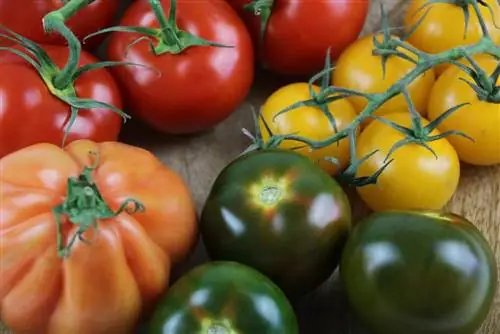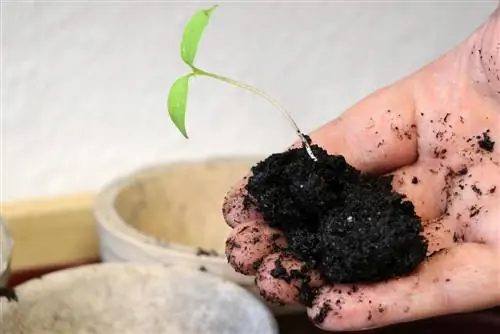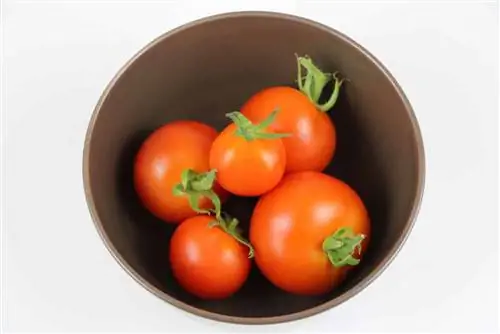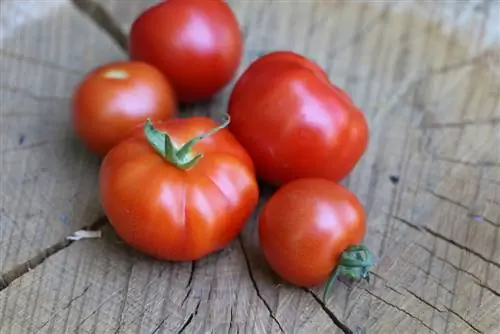- Author admin [email protected].
- Public 2023-12-17 03:39.
- Last modified 2025-06-01 06:48.
Fruits from your own harvest cannot be compared with those from the supermarket. They are more aromatic and fruity and come in different shapes and colors. To cultivate on your balcony at home, you can grow your own plants from seeds or buy ready-made young plants from garden shops. There are no special varieties for growing on the balcony, but there are varieties that are particularly suitable for this type of cultivation.
Recommended varieties for the balcony
Tomato varieties differ not only in shape and color, but also in growth habit. You can choose between bush, stick and cocktail tomatoes. The latter are particularly often used for growing tomatoes on the balcony. The variety of varieties is huge, so there is something to suit every taste. If there is enough space and for greater diversity, it is possible to grow different varieties. Some varieties are particularly suitable for growing on the balcony:
Cocktail tomatoes
Angora Super Sweet
This medium-early ripening cocktail tomato has 3 - 6 cm small, extremely aromatic red fruits. They are sweet, mild and juicy but not floury. The light, downy hair on the fruits is unusual. Their height is between 120 and 250 cm.
Black Cherry
The fruits of this early-ripening stick tomato have a purple to dark brown color when ripe. They are burst-proof and have a juicy, sweet taste. The maximum height is 200 cm.
Black Zebra Cherry
The special thing about 'Black Zebra Cherry' is the dark red base color with the emerald green, irregular stripes. The fruits are round, firm, 2.0 - 2.5 cm in size, with a spicy, sweet note. The growth height in the pot is 120 - 140 cm. Harvest time begins around mid-August.
Cuban Yellow Grape
This high-yielding variety is a very hardy wild tomato with small yellow, egg-shaped fruits weighing up to 20 g. The taste is sweet and aromatic and the height in the pot is a maximum of 250 cm.
Bush tomatoes
Primabell
The bush tomato 'Primabell' is a very compact, early-ripening and high-yielding pot tomato with round, intense red, approx. 30 g heavy and very aromatic fruits. With a size of 30 - 40 cm, this dwarf tomato remains very small.
Balcony Star
The 'Balkonstar' variety is also ideal for cultivation as a balcony tomato. It only grows up to 60 cm high and produces an abundance of deep red, round fruits that are ready to harvest from August. They are medium-sized, burst-resistant with a slightly lemony aroma.
Tumbling ‘Tom Red’
'Tumbling Tom Red' has a hanging habit and is therefore very suitable for hanging baskets. The round, red, 4 - 6 cm small and very juicy fruits have a particularly sweet aroma. Harvest time is from July to September.
Red Robin
The compact and high-yielding bush tomato 'Red Robin' only grows to a height of approx. 30 cm and develops round, red, sweet-aromatic fruits. Harvest time is from July to October.
Steel tomato 'Green Zebra'
The special thing about this tomato is the green-yellow striped color of the fully ripe fruits. Its aroma is intensely spicy, freshly fruity with a fine acidity. Harvesting can begin from the end of July. The plants grow up to 125 cm high.
Tip:
If you only have a very small balcony, it is best to opt for cocktail tomatoes, they remain comparatively low and are very productive. So-called bottle tomatoes, which can grow up to 500 cm high, are completely unsuitable for keeping in containers.
Pre-culture in the house
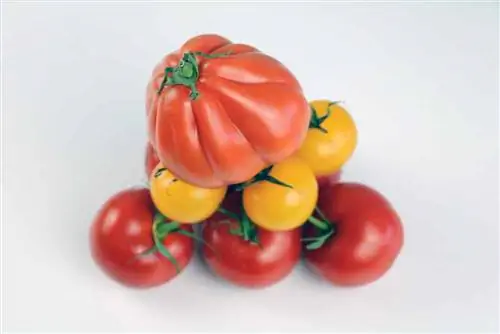
To grow tomatoes on the balcony, you can buy ready-made young plants or grow them yourself. Appropriate seeds are available at any gardening store, hardware store or online. You need commercially available mini greenhouses or use small flower pots that are covered with translucent film. The best time to sow is from the end of February.
- First let the seeds soak in warm water for a few hours
- Then distribute seeds on a nutrient-poor sowing substrate
- Cover about 0.5 cm with soil
- Moisten the substrate and attach the cover
- Put the whole thing in a bright and warm place
- Germination temperatures between 20 and 24 degrees are optimal
- Remove cover when seedlings have at least two pairs of leaves
- From a size of approx. 10 cm, separate into small pots
To prevent the plants from turning, place them a little cooler but still bright without exposing them to the blazing sun. Now they must not be too dry or too wet. They are now growing relatively quickly. Before they are allowed outside onto the balcony, they must be repotted into sufficiently large planters.
The right planter
The larger the planter, the better it is for the plants. The material doesn't matter. Not only pots and tubs are possible, depending on the type of tomato, hanging baskets or plant bags so-called crow bags are also suitable. Compared to conventional pots, plant bags have the advantage that they are already filled with high-quality soil, which supplies the plants with all the important nutrients for around 6 weeks.
The plant bag is practically the planter. The plants are planted directly into pre-made openings. Evaporation is significantly lower than with buckets. The bags can be placed on the ground and planted directly. Plant 1 - 2 seedlings per bag. Decorative hanging baskets are suitable for small and hanging tomato varieties, such as flat-bushy Thumbling varieties.
But the most common planting is still in pots. They should have a capacity of at least 10 liters. With two plants per pot, there should be a good 40 liters and planting distances of 60 - 80 cm should be maintained. In addition, good drainage must be ensured.
Tip:
For varieties that grow very large, it is advisable to cultivate them with two to three shoots. This has the advantage that the growth is spread over several shoots and the plants remain significantly lower with the same yields.
Plants
- A drainage layer in the planter before planting
- Coarse gravel or pottery shards are suitable
- Plant tomato plants as deeply as possible
- Ideally down to the lowest leaf base
- Then press soil and water
- Use support rods for stabilization
- Plants could break due to the weight of the fruit
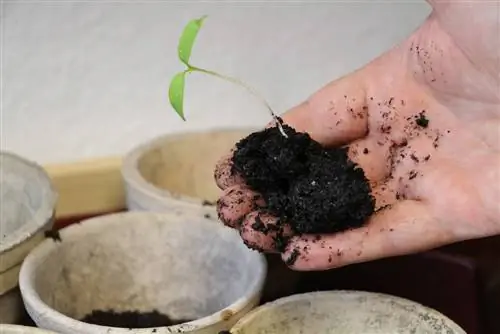
Planting deeply has the advantage that additional roots form on the lower part of the stem and the plants can thus better supply themselves with water and nutrients. Planting basil or nasturtium between tomato plants can enhance the aroma of the tomatoes and minimize evaporation.
Tip:
Once the plant reaches a certain size, it is advisable to remove the lowest leaves close to the ground to protect them from moisture caused by splashing water. Otherwise there is a risk of brown rot.
Site conditions
Tomatoes generally prefer warm, dry locations protected from wind and rain with as much sun as possible. Consequently, balconies with a southern or southwestern orientation are ideal; the light output is highest here. Heat is not a problem for these plants as long as they are provided with sufficient water.
The situation is different with moisture from above or rain, which doesn't affect tomato plants at all. Wet leaves promote the development of fungal diseases such as brown rot, which quickly spreads across the plant and fruit. It is best to place the plants under a roof or in a standard tomato house.
Basically, tomatoes grow in any well-drained, fresh and nutrient-rich potting soil. The permeability can be improved by mixing in some fine gravel or expanded clay. There shouldn't be too many coarse parts so that the substrate doesn't lose its stability.
When to go outside?
Tomato plants can be placed on the balcony between mid and late May. No more night frosts should be expected. However, you should give the plants a short adjustment period and slowly get them used to the sun. Otherwise the sensitive leaves will get sunburned very quickly. It's best to put them out for a few days at first only for hours or only during the day. Later, when there is no longer any risk of frost, they can stay outside completely.
Care requirements
Even if you don't have a garden, you don't have to go without home-grown vegetables. Tomatoes in particular can also be grown on a small balcony. In addition to the right location, needs-based care is important.
Pouring
Tomatoes need to be watered regularly, they are extremely thirsty. It is better to water regularly than rarely and intensively. Drought could cause the fruit to split and should be avoided. However, tomatoes don't want to sit in water permanently. When watering, make sure to only water from below and never over the leaves. The best time for this is early in the morning or evening. A layer of mulch ensures that the substrate does not dry out so quickly.
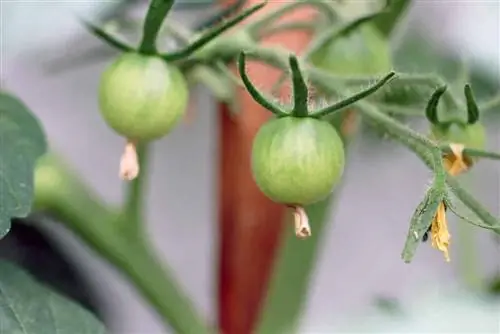
Fertilize
Tomatoes are heavy feeders and require continuous fertilizer applications. Accordingly, you can work a portion of horn shavings or compost into the soil when planting. As soon as the tomato plants bloom and develop the first fruits, the nutrient requirements are particularly high. Special tomato fertilizers are available commercially that contain all the important nutrients and are tailored to the needs of these plants. When it comes to dosage, you should follow the specifications of the respective manufacturer. Or you can work some horn shavings superficially into the moist soil about every six weeks.
Simply
Opinions differ when it comes to pinching out tomato plants. While some recommend maxing out, others advise against it. Pruning involves removing all of those shoots that grow from the leaf axils. Since new so-called stingy instincts continue to develop, the whole thing has to be repeated several times throughout the entire culture. Thinning is recommended, especially for single-shoot varieties. For multi-shoot tomatoes such as bush tomatoes, it is better to avoid them and simply let them grow. Austerity has both advantages and disadvantages.
Advantages
- Maximizing makes sense if you want to harvest larger but fewer fruits
- When space is limited
- Maximized plants are better ventilated
- This can counteract the spread of fungal diseases
- Removed shoots can be left on the ground as a kind of mulch
- This is how you provide the plants with an extra portion of fertilizer
Disadvantages
- Removing the stingy shoots creates open wounds
- This promotes the penetration of pathogens
- Without thinning, the plants grow very compact and lose stability
- Removing the stingy shoots is a regular maintenance effort
- It is necessary about once a week
- Fruit shoots can be accidentally cut off
- This reduces the harvest
Tip:
Pick off fresh shoots with your fingers and carefully cut them out. Slightly older ones are usually stronger and firmer, making them easy to break out.
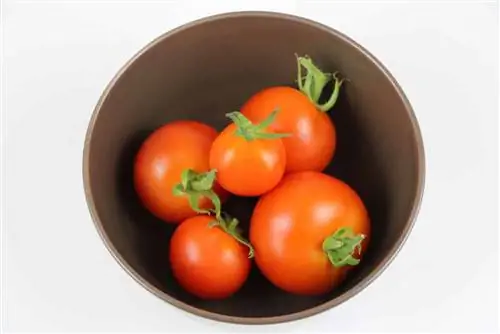
Harvest ripe and unripe tomatoes
Between July and October the time has finally come and the aromatic fruits can be harvested. Fully ripe fruits of red varieties are completely colored. The full ripeness of multi-colored, yellow, orange or green varieties can be recognized by the fact that the peel gives slightly under pressure. Another indication that tomatoes are ripe is the predetermined breaking point on the stem, where the fruit can be easily snapped off.
There are special green varieties that retain their green color even when fully ripe and can be eaten without any problems. All others are only green when unripe and therefore not edible. Due to the weather, the first frost may threaten before all the fruits are ripe or they simply haven't received enough sunlight. Then they don't have to be thrown away under any circumstances, but you can harvest them as normal and let them ripen in a dark and cool place. However, the taste is not as good as sun-ripened tomatoes.
Conclusion
Growing tomatoes on the balcony is a good and, above all, delicious alternative to tomatoes from the supermarket. The effort required for this is relatively low. You should pay particular attention to choosing the right variety, a sunny location protected from rain and an optimal supply of nutrients. Then nothing stands in the way of a rich harvest on your own balcony.

